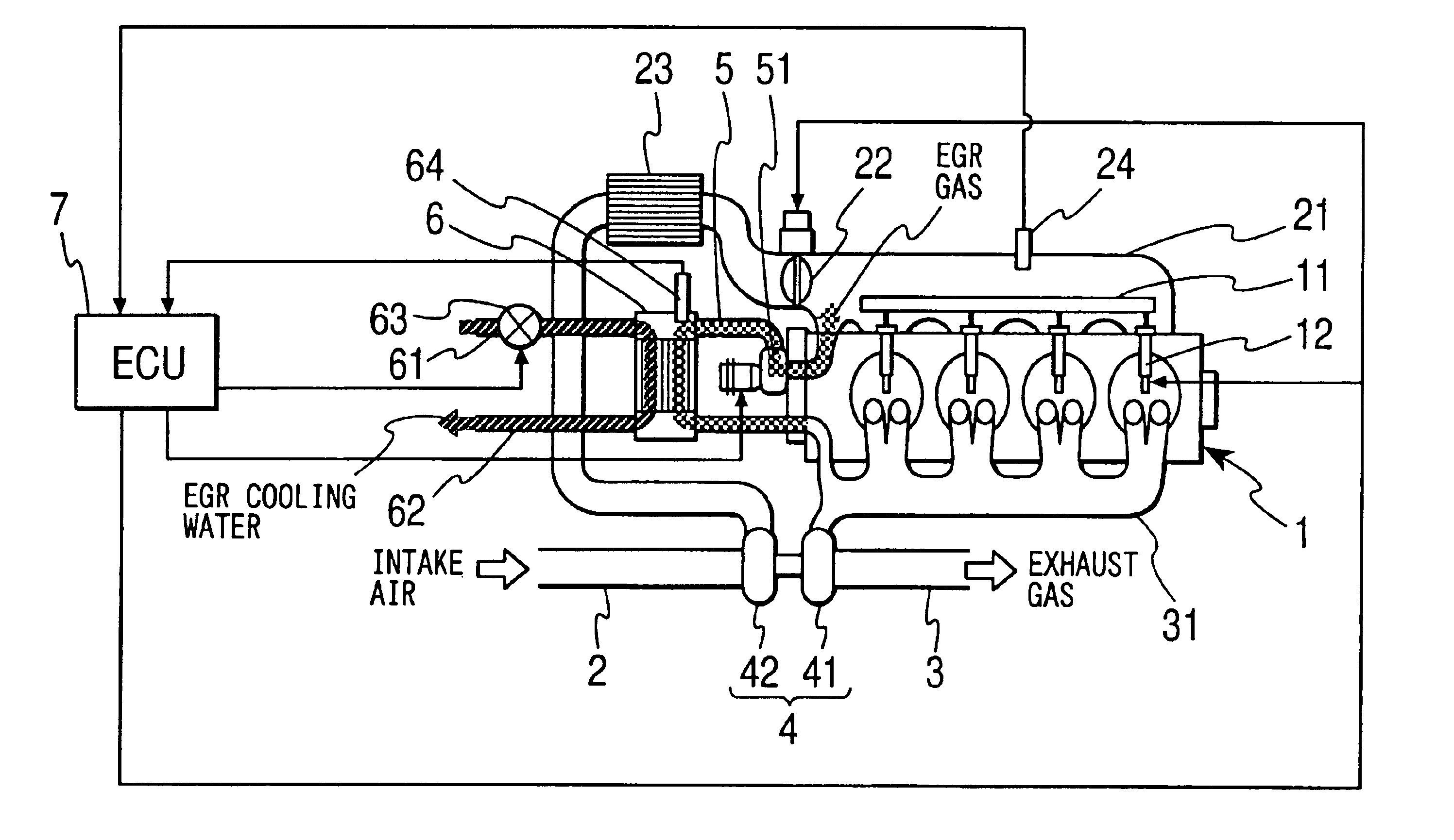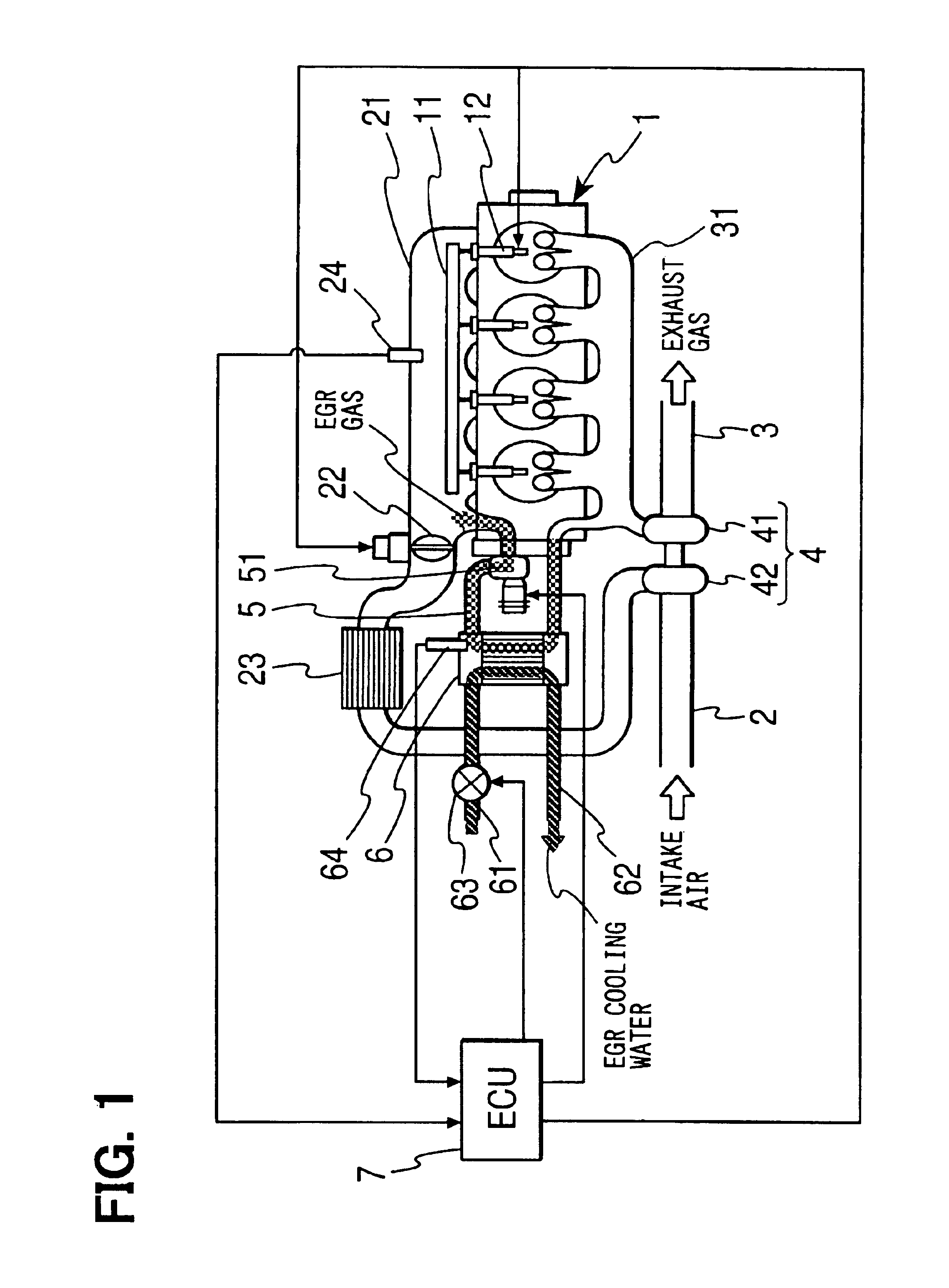Exhaust gas recirculation system having cooler
a technology of exhaust gas recirculation and cooler, which is applied in the direction of mechanical equipment, machines/engines, electric control, etc., can solve the problems of reducing heat exchange efficiency and cooling performan
- Summary
- Abstract
- Description
- Claims
- Application Information
AI Technical Summary
Benefits of technology
Problems solved by technology
Method used
Image
Examples
first embodiment
(First Embodiment)
Referring to FIG. 1, an engine 1 having an exhaust gas recirculation system according to the first embodiment is illustrated. The engine 1 has a common rail 11, which is common to respective cylinders of the engine 1, and fuel injection valves 12. Each fuel injection valve 12 is connected with the common rail 11 and injects fuel into a combustion chamber of each cylinder of the engine 1. An intake manifold 21 of the engine 1 is connected with an intake pipe 2. An intake throttle 22 is disposed at the connection between the intake manifold 21 and the intake pipe 2. The intake throttle 22 regulates a flow rate of intake air.
An exhaust manifold 31 of the engine 1 is connected with an exhaust pipe 3. A turbine 41 of a centrifugal supercharger 4 is disposed in the exhaust pipe 3. A compressor 42 is disposed in the intake pipe 2. The turbine 41 is connected with the compressor 42 through a turbine shaft. The turbine 41 is driven with the use of thermal energy of the exha...
second embodiment
(Second Embodiment)
An internal combustion engine 1 having an EGR system according to the second embodiment is illustrated in FIGS. 4A, 4B and 5. In the EGR system according to the second embodiment, the intake throttle 22 is rotated toward a closing direction from a usual position when the exhaust gas is heated to regenerate the cooling performance of the EGR cooler 6 as shown in FIGS. 4A and 4B. FIG. 4A shows a state in which the intake throttle 22 is at the usual position. FIG. 4B shows a state in which the intake throttle 22 is rotated toward the closing direction from the usual position. Thus, the flow rate of the intake air is decreased and thermal capacity of the gas entering the combustion chamber of the engine 1 is reduced. As a result, the exhaust gas is heated to a temperature at which the soot and the unburned hydrocarbon are oxidized and eliminated.
Next, a processing performed by the ECU 7 according to the second embodiment will be explained based on a flowchart shown in...
third embodiment
(Third Embodiment)
An internal combustion engine 1 having an EGR system according to the third embodiment is illustrated in FIGS. 6 and 7. In order to increase the temperature in the EGR cooler 6 and to regenerate the cooling performance, the EGR system according to the third embodiment delays the fuel injection timing from the usual injection timing as shown in FIG. 6. A broken line LN in FIG. 6 shows a nozzle lifting degree of the fuel injection nozzle at the usual fuel injection timing and a solid line LD in FIG. 6 shows the nozzle lifting degree at the delayed fuel injection timing. In this case too, like the case of the multi-injection, part of combustion energy is converted into the thermal energy of the exhaust gas (not into the motive energy). As a result, the temperature of the exhaust gas is increased and the soot or the unburned hydrocarbon is eliminated by the oxidization.
Next, a processing performed by the ECU 7 according to the third embodiment will be explained based o...
PUM
 Login to View More
Login to View More Abstract
Description
Claims
Application Information
 Login to View More
Login to View More - R&D
- Intellectual Property
- Life Sciences
- Materials
- Tech Scout
- Unparalleled Data Quality
- Higher Quality Content
- 60% Fewer Hallucinations
Browse by: Latest US Patents, China's latest patents, Technical Efficacy Thesaurus, Application Domain, Technology Topic, Popular Technical Reports.
© 2025 PatSnap. All rights reserved.Legal|Privacy policy|Modern Slavery Act Transparency Statement|Sitemap|About US| Contact US: help@patsnap.com



